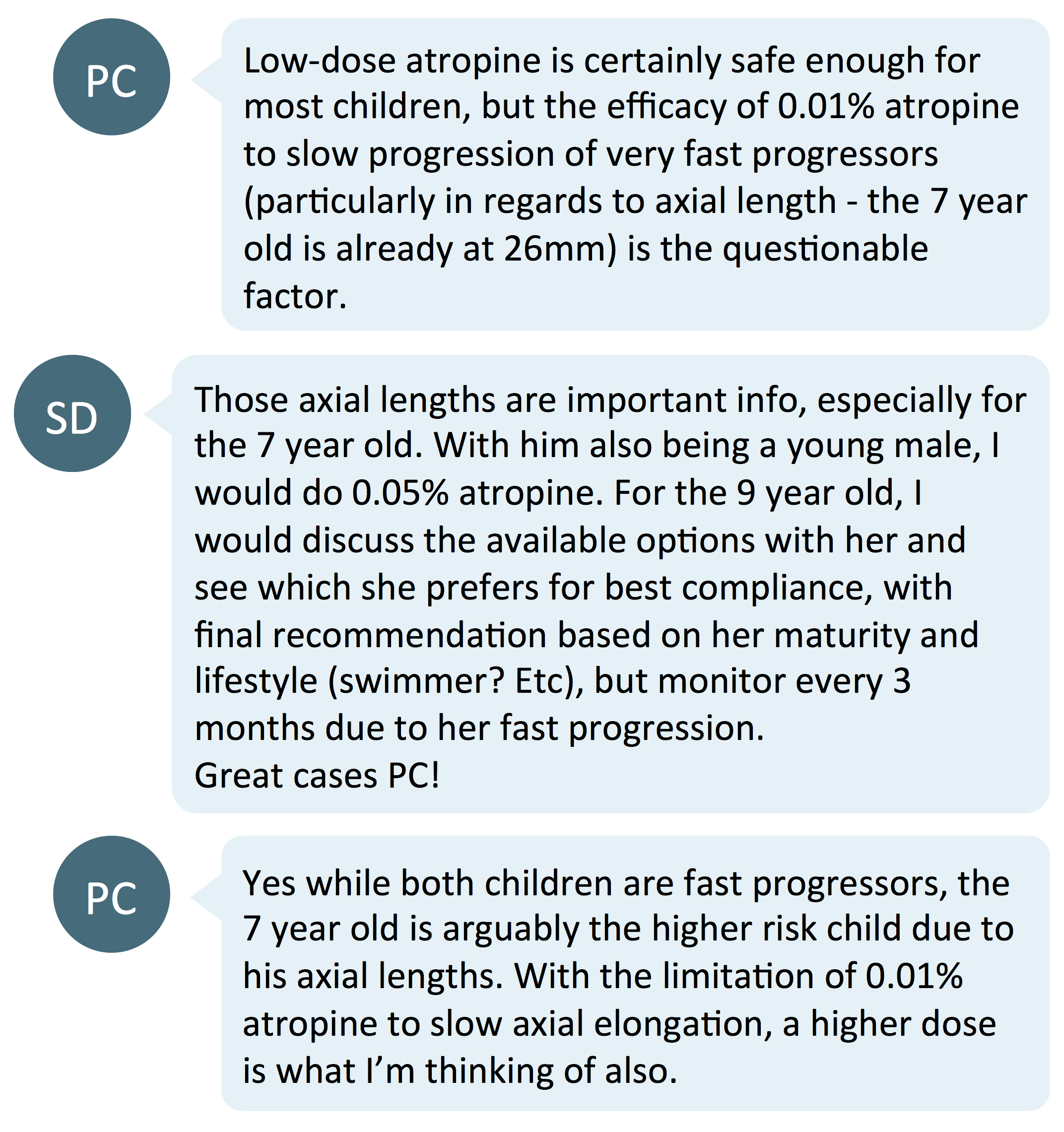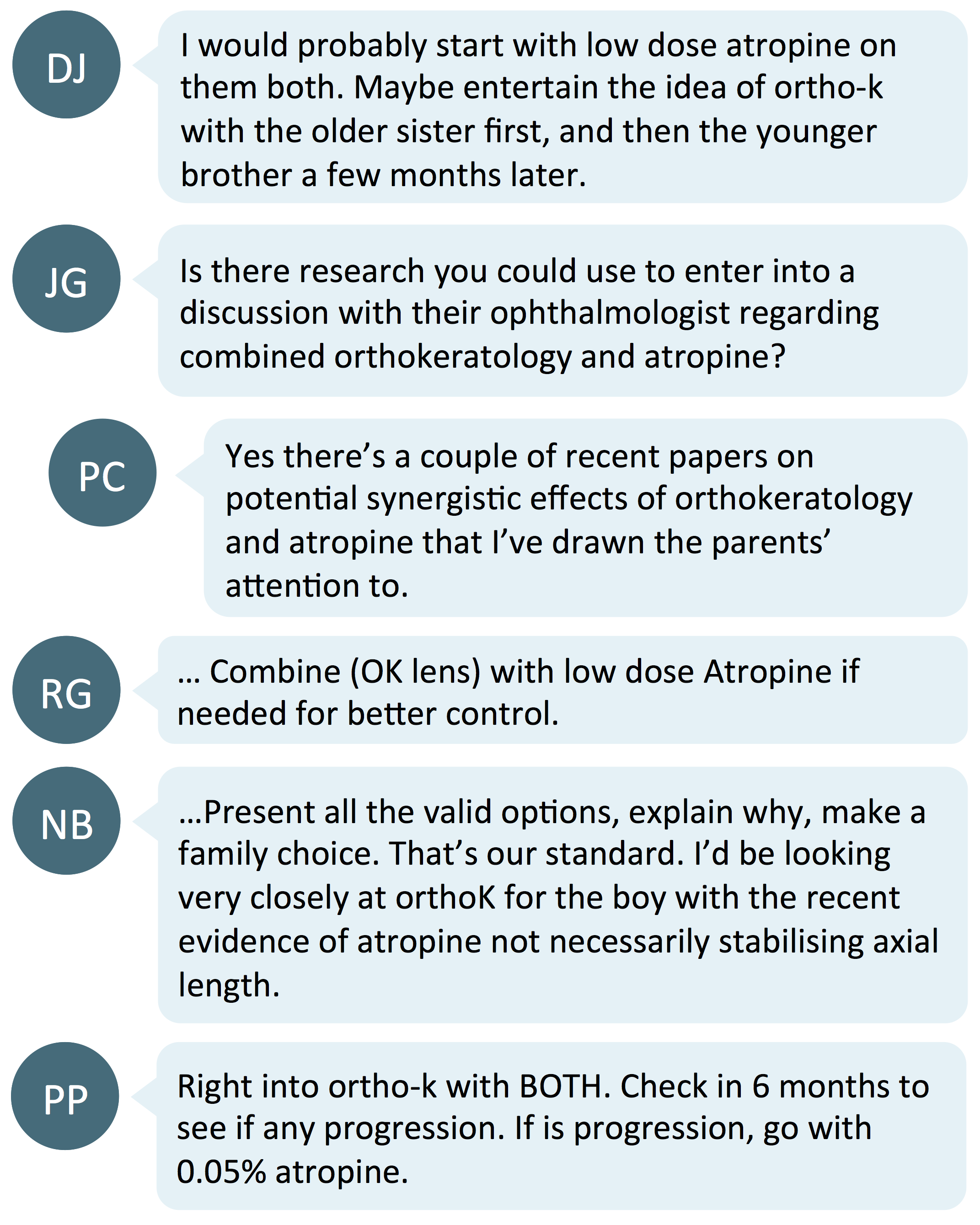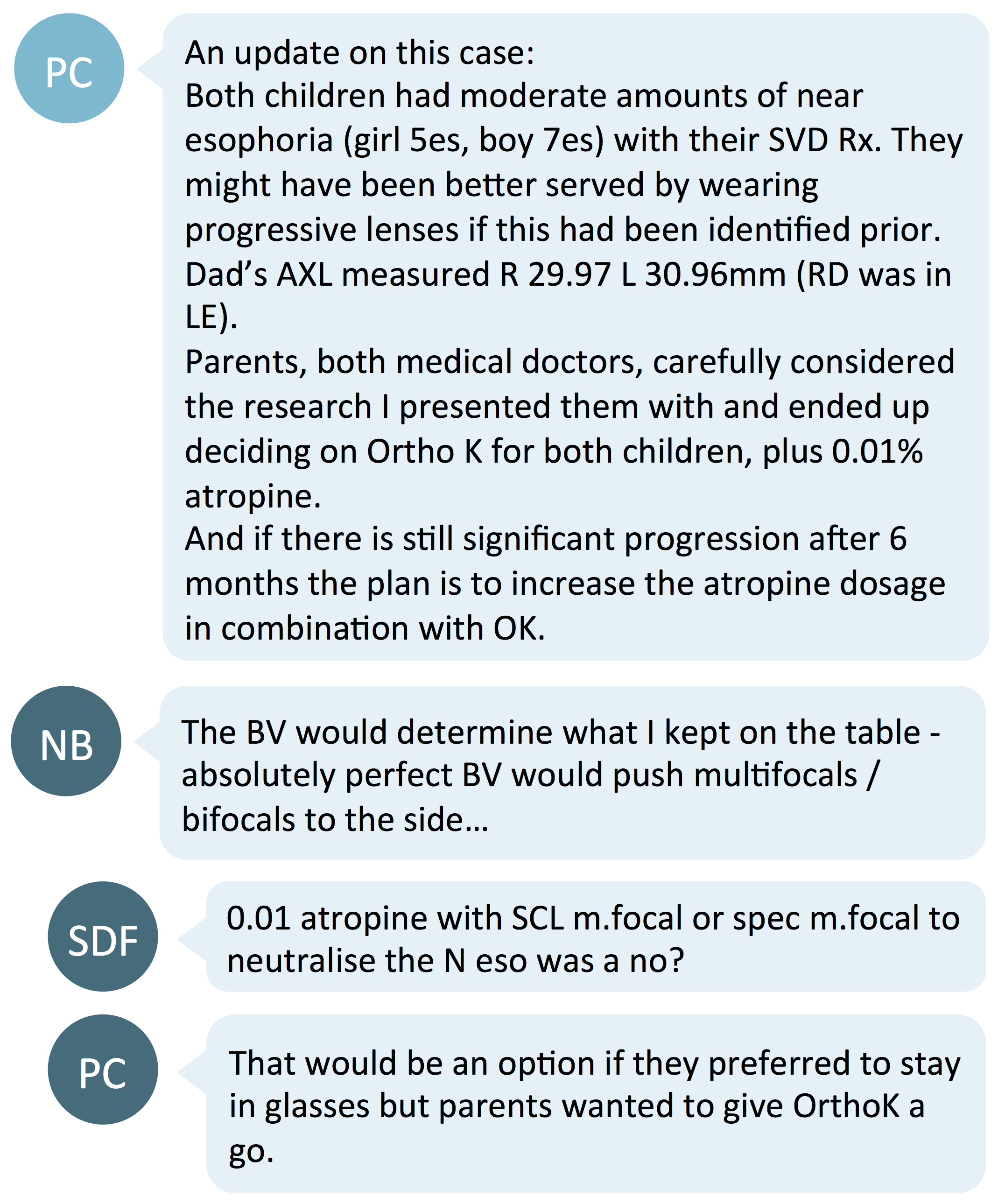The decision to commence a myopia control treatment is simple when the parent asks for it, seeing rapid progression in their children as concerning. When getting started, how to do you select and discuss the best strategy? PC opened a discussion about the decision-making process of deciding on initial myopia treatment in the following case involving fast myopia progressors with a family history of very high myopia.

Considering the risk factors
In assessing risk for myopia progression, these siblings have two key factors that indicate the need for a proactive myopia control strategy.
- Young age - being under age 9 at myopia onset1
- Parental myopia - Both parents are myopic, including one with very high myopia2
Their ethnicity is not mentioned, but children of Asian ethnicity are additionally at risk of faster myopia progression.3 Ethnicity is important because Asian ethnicity is a key risk factor for myopia onset and progression, compared to other ethnicities, regardless of country of residence. Each of these three risk factors – age, parental myopia and ethnicity – are of course not modifiable, but important to identify as a myopia managing practitioner. You may choose not to discuss ethnicity as a risk factor with parents, where there may be sensitivity or it may not seem helpful, but even so it is worth keeping in mind clinically to help drive a proactive treatment strategy.
Additional need for myopia control is indicated by:
- Current myopia intervention - both children are wearing single vision distance optical correction, so myopia progression is not controlled
- Myopia progression - around 1D in six months, indicating fast progression. it is important to note, though, that prior progression doesn't always predict future progression as a single factor - bringing age of onset and parental myopia into consideration is important4
- Axial length - the 7-year-old boy's axial length is close to 26mm, which is especially concerning given this appears to be the delineator for a significant increase in lifelong risk of ocular disease and vision impairment.5
First suggestion - atropine
The post reports that these two siblings had recently seen an ophthalmologist, who recommended 0.01% atropine. Given that the efficacy of atropine as a monotherapy has been shown most recently to be concentration-dependent,6 it would make sense to consider a higher concentration for better efficacy.

The LAMP study showed a dose-dependent efficacy of low-dose atropine, whereby 0.05% atropine was twice as effective than 0.01%.6 If low-dose atropine is used as monotherapy, then 0.05% atropine would perhaps be the best starting point. To read more about deciding on prescribing atropine, check out When to prescribe atropine for myopia control.
What about an optical strategy?

With moderate myopia, the children need an optical correction, and there are options for myopia correction and control with specific spectacle and contact lens types. Most commenters recommended contact lens options, noting the safety and efficacy of contact lens options for children, especially under age 12.
In this case, the ophthalmologist recommended against the use of contact lenses for the two siblings. Common concerns with contact lens use in kids surround safety. Read more about this in Contact Lens Safety in Kids.
For atropine monotherapy, progressive addition (multifocal) spectacles with photochromic treatment can be important to manage potential side effects of atropine. The low-dose atropine for myopia progression (LAMP) study found that around 30% of children requested photochromic spectacles due to glare symptoms, regardless of the atropine dosage (0.01%, 0.025% and 0.05%) - and even on the placebo treatment too. Only a 1 or 2 out of a hundred had near vision symptoms, again similar across the groups, and were prescribed progressive addition spectacle lenses.6
Only accommodative amplitude was tested and questions of near vision symptoms was asked in the LAMP study. Aside from this, there has been minimal investigation of other clinical measures of accommodative function in atropine treatment. One recent study found that 0.01% atropine did not affect accommodative facility in Chinese children wearing single vision spectacles. These results could potentially be different with stronger concentrations and in children with lighter iris colours, who may show greater mydriatic response.7
Combining atropine with an optical strategy

In combining atropine with an optical strategy - myopia controlling spectacles or contact lenses - the only data available is that on combining orthokeratology (OK) with varying concentrations of atropine, mostly 0.01%. A recent meta-analysis showed that this combination reduces axial elongation by a weighted mean difference of 0.09mm compared to OK alone over one year. This was from the basis of three short-term (1, 6 and 12 month) and two long-term (24 month) retrospective studies, neither of which were randomized.8
The first prospective, randomized controlled trial on OK and 0.01% atropine has shown similar results. In myopes of -1.00 to -3.00D, axial elongation was 0.18mm less over two years in the combination treatment group. In myopes of -3.01 to -6.00D, axial length increased more slowly overall and there was no difference when atropine was added to OK.9
More clinical trials are currently underway, including the first on combining 0.01% atropine with multifocal soft contact lenses. Initial results have shown good short-term tolerance of the combined treatment.10
What happened in the end?

In the end, the parents decided to try orthokeratology lenses with 0.01% atropine. This is an evidence-based choice, to both correct and control myopia based on the latest research.
Further testing has revealed that the children exhibit near esophoria in their single vision corrections. The esophoria could have been managed with progressive addition spectacle lenses, which have also shown mild myopia controlling effects for such children.11 Orthokeratology, however, will also offer a small exophoric shift compared to a single vision correction.12
Take home messages:
- In considering the clinical findings and cluster of risk factors for fast myopia progression in these children, a proactive myopia management strategy is needed. Younger age and parental myopia indicate a higher risk of faster progression, alongside Asian ethnicity. Prior fast progression doesn't always predict future fast progression but it can be a factor.
- An optical correction of spectacles or contact lenses is required for myopes, so considering a treatment strategy which both corrects and controls myopia is ideal. There is early evidence for combining low-dose (most frequently 0.01%) atropine with orthokeratology to achieve additive efficacy, with more research underway. Atropine 0.01% as a monotherapy is not the most effective strategy to select as a first line treatment, based on current evidence.

About Kimberley
Kimberley Ngu is a clinical optometrist from Perth, Australia, with experience in patient education programs, having practiced in both Australia and Singapore.

About Connie
Connie Gan is a clinical optometrist from Kedah, Malaysia, who provides comprehensive vision care for children and runs the myopia management service in her clinical practice.
This content is brought to you thanks to an unrestricted educational grant from
![]()
References
- Chua SY, Sabanayagam C, Cheung YB, Chia A, Valenzuela RK, Tan D, Wong TY, Cheng CY, Saw SM. Age of onset of myopia predicts risk of high myopia in later childhood in myopic Singapore children. Ophthalmic Physiol Opt. 2016;36(4):388-94. (link)
- Liao C, Ding X, Han X, Jiang Y, Zhang J, Scheetz J, He M. Role of Parental Refractive Status in Myopia Progression: 12-Year Annual Observation From the Guangzhou Twin Eye Study. Invest Ophthalmol Vis Sci. 2019;60(10):3499-3506. (link)
- Jiang X, Tarczy-Hornoch K, Cotter SA, Matsumura S, Mitchell P, Rose KA, Katz J, Saw SM, Varma R; POPEYE Consortium. Association of Parental Myopia With Higher Risk of Myopia Among Multiethnic Children Before School Age. JAMA Ophthalmol. 2020 May 1;138(5):501-509. (link)
- Brennan NA, Matsumara S, Htoon HM, Kathrani BK, Tan CS, Lanca C, Tan D, Sabanayagam C, Saw SM. Annual myopia progression and subsequent year progression in Singaporean children. Invest Ophthalmol Vis Sci. 2020;61(7):76. (link)
- Tideman JW, Snabel MC, Tedja MS, Van Rijn GA, Wong KT, Kuijpers RW, Vingerling JR, Hofman A, Buitendijk GH, Keunen JE, Boon CJ. Association of axial length with risk of uncorrectable visual impairment for Europeans with myopia. JAMA Ophthalmol. 2016 Dec 1;134(12):1355-63. (link)
- Yam JC, Jiang Y, Tang SM et al. Low-Concentration Atropine for Myopia Progression (LAMP) Study. Ophthalmol. 2019;126:113-24. (link)
- Obianwu HO, Rand MJ. The relationship between the mydriatic action of ephedrine and the colour of the iris. Br J Ophthalmol. 1965;49(5):264-270. (link)
- Gao C, Wan S, Zhang Y, Han J. The efficacy of atropine combined with orthokeratology in slowing axial elongation of myopia children: a meta-analysis. Eye & Contact Lens. 2021 Feb 1;47(2):98-103. (link)
- Kinoshita N, Konno Y, Hamada N, Kanda Y, Shimmura-Tomita M, Kaburaki T, Kakehashi A. Efficacy of combined orthokeratology and 0.01% atropine solution for slowing axial elongation in children with myopia: a 2-year randomised trial. Sci Rep. 2020 Jul 29;10(1):12750. (link)
- Huang J, Mutti DO, Jones-Jordan LA, Walline JJ. Bifocal & Atropine in Myopia (BAM) Study: Baseline Data and Methods. Optometry and vision science: official publication of the American Academy of Optometry. 2019 May;96(5):335. (link)
- Gwiazda J, Hyman L, Hussein M et al. A randomized clinical trial of progressive addition lenses versus single vision lenses on the progression of myopia in children. Invest Ophthalmol Vis Sci 2003;44:1492-1500. (link)
- Gifford KL, Gifford P, Hendicott PL, Schmid KL. Zone of Clear Single Binocular Vision in Myopic Orthokeratology. Eye Contact Lens. 2020;46(2):82-90. (link)











